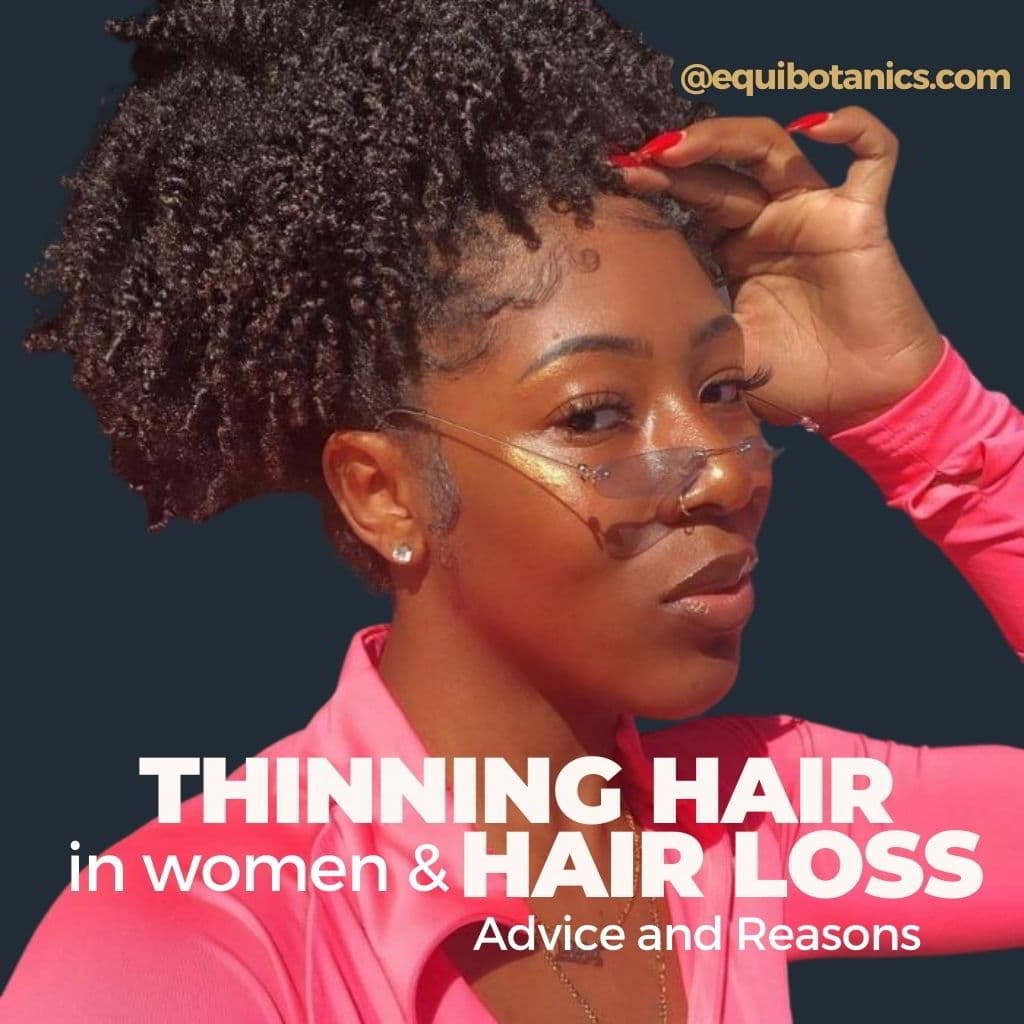
Hair loss, thinning, and balding are conditions more commonly associated with men. However, it is a condition that also affects many women.
If you feel that your hair loss is becoming more extreme, there could be several reasons, including stress, age, health, and even certain hairstyles. While it is difficult to see the light at the end of the tunnel, the good news is that hair loss and thinning can be treated.
We’re on hand to help you understand more about hair loss and thinning in women, why it occurs, and ways to treat it.
Key Findings
- Genetics, ageing, illness, stress, and a lack of vitamins can cause hair loss.
- Hair loss can look different depending on the type you are suffering from. For example, you may have patches, general thinning or a receding hairline.
- There are medical and natural methods to treat hair loss, including prescription medication, scalp massages and natural hair care products.
12 Reasons for Hair Thinning and Loss

It’s normal to shed hair; on average, we lose between 50-100 hairs a day, which often goes unnoticed. Hair loss is worrying for women that experience it, and while it isn’t usually something to be concerned about, it is sometimes a symptom of an underlying medical condition. If you are a female, wondering why your hair is thinning all of a sudden, we’ve got the answers here:
1. Genetics
A common cause of hair loss in women is female pattern baldness. This genetic condition, also known as androgenetic alopecia, can also be caused by ageing or hormonal imbalances. It tends to cause crown hair thinning while remaining normal at the hairline, with thinning hair also noticeable at the temples and parting.
2. Illness
Thinning hair and fallout can be because of something internal, such as a thyroid problem, inflammatory condition, or autoimmune disorders like Crohn’s Disease and Lupus. Alopecia Areata is another illness that results in hair loss. This disease causes the immune system to attack hair follicles triggering significant hair fall. It is often identifiable by patches on the scalp. The condition itself is not curable, but hair can regrow.
3. Stress
If you have experienced a traumatic event or are under a lot of stress, it can trigger telogen effluvium, which sees hair enter the resting phase early, causing locks to shed excessively. With telogen effluvium, you will have a noticeable decline in the volume of your hair. On average, you will lose around 300 hairs a day compared to the usual 50-100 strands.
Also, if you are wondering why your hair is thinning on one side only, this could be a result of stress or if you’ve suffered trauma to that side of your head.
4. Medical Treatments
Certain medications and treatments such as chemotherapy or radiation therapy can lead to anagen effluvium which causes hair loss all over the body, including the head. It occurs to hair in the growth stage and can occasionally be permanent if it damages the hair follicles.
5. Weight Loss
Hair loss can occur in those who lose weight through a restrictive diet or surgery. Typically, you will notice an increase in shedding and overall thinning rather than patches. It’s often as a result of stress placed on the body (or a nutrient deficiency). Fortunately, it’s usually only temporary.
6. Scalp Conditions
If you suffer with dandruff, psoriasis, dermatitis or other scalp condition, a common symptom is itchiness, but scratching an itchy scalp can damage the hair follicles, in turn causing loss and thinning.
7. Age
A fact of life as we age is that hair follicles can’t create hair as quickly as in our youth, which slows the growth rate of hair down significantly for many. Hair continues to shed as part of its usual cycle but sometimes, the rate of hair production isn’t there to replace it which can leave hair looking thin and patchy as a result.
8. Iron Deficiency
A lack of iron is a common cause of hair thinning and fall out in women. When iron levels are low, it becomes harder for oxygen to travel to the cells that stimulate hair growth, which can then cause hair strands to fall out.
9. Hairstyling
Certain hair styles such as tight ponytails, braids, or corn rows, as well as regular use of hair extensions, can cause traction alopecia. This type of hair loss occurs because of the stress these hair styles place on the hair follicles, causing damage that can sometimes be permanent.
Even heat exposure from hair tools and harsh brushing, especially on wet hair, can cause damage and breakage to locks.
10. Over-Processing
If your hair is over-processed as a result of chemical straightening, or regular bleaching, it is likely to be dry and dehydrated. This can leave it prone to breakages and lacking in volume. Over processing can also impact scalp health, causing patches of hair loss across the head.
11. Diet
A balanced diet is important to support hair health, and if you are lacking in certain vitamins and nutrients, it can lead to hair loss. Vitamins and minerals can contribute to blood circulation to the scalp, production of keratin, strengthening follicles and renewing tissue. Making dietary lifestyle changes, such as becoming vegan, can cause disruption to the hair’s vitamin supply and trigger loss.
12. Hormones
Hair thinning and fall out is common with hormonal changes such as the menopause, as well as after pregnancy.
During menopause, a woman’s oestrogen and progesterone levels decline, and hair growth becomes slower, leading to thinning tresses. When these hormones decline, it can also cause androgens to shrink hair follicles which triggers hair loss, but it is rarely permanent.
Pregnancy hair loss is caused by falling oestrogen levels and tends to last up to 6 months after childbirth. It can seem like a large volume of hair is falling out, as often, during pregnancy, shedding tends to slow down. The regular cycle resumes post-partum, which rids your scalp of all the additional hair retained throughout pregnancy.
What Can a Female do for Thinning Hair? Hair Loss Advice

Although hair loss can be distressing, the good news is that thinning hair in women can grow back. There are plenty of natural and medical treatments available to restore hair loss and encourage regrowth, with results starting to show in as little as 3 weeks. Keep consistent and patient whilst trying out the following methods to regrow hair:
Hair Wash Routine
You may notice more hair coming out in the shower, which can be stressful, however these strands were already loose and are now simply being washed away by the running water.
Hair washing does not cause hair loss. It is important to maintain a consistent, regular hair washing routine during periods of hair loss to remove dirt and oil that can block follicles, leading to further loss and scalp damage.
Try a gentle, cleansing shampoo formula such as the Baobab Detangler & Cleanser which works to clean hair without stripping it of essential moisture needed for healthy growth.
Baobab Hair Detangler & Cleanser
We prefer to avoid calling this a detangling shampoo. Instead, we call ours a detangling cleanser because it’s softening and moisturising while cleansing thoroughly. It also acts as your pre-poo detangler before you wash. Are you tired of that stripped feeling after you’ve just washed your hair? Wash your hair not strip it of its natural oils.
Hair Care Products
When experiencing loss and thinning, your hair and scalp are particularly fragile and delicate. Change any chemically-formulated hair care products, especially those that contain sulphates, to naturally-derived ones. We would recommend the Afro Hair Care Growth Set, as it contains targeted hair thinning products which work to keep your locks hydrated, repair damage and stimulate hair growth.
Afro Hair Care Growth Set
We've jam-packed this Growth Set with luxurious ingredients to give you a kickstart on your hair growth journey. We've selected our best-selling and hair replenishing treatments as part of the set. And because we really want you to have a great time, we're giving this set away for less than getting each product individually.
If you have over-processed hair from salon treatments, then your locks require moisture – and lots of it. Use a mask twice a week (here’s how) for much needed hydration, and apply a hair oil, such as the Black Seed Hair Oil Elixir. Not only will this restore damaged hair, but it also works to prevent hair loss and encourage regrowth as it contains a potent blend of 33 oils and actives, including black seed oil.
Black Seed Hair Oil Elixir
This Black Seed Oil For Hair is enriched with Fenugreek, Brahmi and Bhringaraj ayurvedic oils, our first hair serum is your best bet to reaching your hair goals. Stop split ends, check. Stop itchy scalp, check. Help accelerate growth, check check check. We've jam-packed this little bottle with luxurious ingredients from the Caribbean, India and the Amazonian rainforest to give you longer, thicker, and stronger hair in less time.
Hair Styling
When it comes to heat styling, try to allow hair to air dry where possible. On occasions where you need to use heat stylers, keep the heat on lower settings and use a heat protectant spray. Brushing should also be performed gently (and avoided when wet) as this is when hair is at its most fragile, and more prone to damage.
For traction alopecia sufferers looking to encourage regrowth, try to avoid hair extensions. If you are a fan of protective styling, ask your stylist to create looser braids and have them removed every three months. Always try to have a two week break in between styles.
Trichologist
Visiting a trichologist when suffering with hair loss can help to set your mind at ease. Trichologists can identify a range of hair and scalp issues including chronic hair thinning, genetic hair loss and scalp conditions like dandruff. They will be able to professionally investigate the cause of your hair loss or thinning as well as suggest methods, such as topical medications or infrared therapies.
Massage
Massage is a powerful tool for your scalp that encourages growth by stimulating blood flow. Performing a daily scalp massage for 5 minutes can also rid the scalp of dead skin cells to create a healthy base for faster hair growth. Using a hair oil to perform a longer massage before hair wash days will further help to hydrate the scalp and encourage circulation.
Platelet-Rich Plasma Therapy
A relatively new cosmetic treatment, PRP therapy, sees your blood being drawn by a qualified practitioner, divided into separate components, recombined with plasma and a high concentration of platelets, and then injected back into the scalp.
It’s particularly effective for those with androgenetic alopecia with the growth factors in platelets encouraging the hair follicles to regenerate to stimulate hair growth. Studies into this contemporary therapy have demonstrated significant reduction in hair loss by the time of the fourth PRP injection.
Food and Supplement Intake
Hair and scalp health, much like other parts of the body, are dependent on a strong vitamin and nutrient intake. Vitamins and nutrients you will want to consume to improve the growth and condition of your locks include:
Vitamin A: this vitamin helps to produce sebum to stop hair from becoming dry and breaking. It is an antioxidant that helps to fight free radicals that cause hair damage. Eat foods such as fish, eggs and tomatoes to increase your intake of vitamin A.
Vitamin B7: found in foods such as lentils, vitamin B7 stimulates keratin production in hair and increases follicle growth rate to encourage hair growth and reduce loss.
Omega-3: these essential fatty acids help to reduce inflammation around the hair follicles that could be affecting hair growth. Good sources of omega-3 include salmon, nuts and seeds.
Iron: this nutrient plays a significant part in carrying oxygen to the cells in your body that help the hair to grow. Eat leafy greens such as spinach and red meat to increase your iron intake.
Protein: hair follicles are predominantly made up of protein, so it is important to include plenty of protein-rich foods in your diet because a lack of this valuable nutrient can contribute to hair loss. Chicken, nuts, eggs and legumes are all great sources of protein.
As well as making dietary changes to enhance your vitamin and nutrient intake, you could also introduce a hair supplement tablet that will provide you with a further boost in your quest for hair health and regrowth.
Medication
In cases of extreme hair loss, you may wish to consult a medical practitioner who can provide you with a scientific diagnosis. With certain medical conditions, such as female pattern baldness, you may be prescribed Minoxidil which has been clinically proven to treat and reverse hair loss.
What does Hair Loss Look Like?

Different types of hair loss will display in various ways upon the head, from patches to general thinning. Knowing the form of your hair loss can help you to identify the type you are suffering from. We’ve compiled a list of common types of hair loss and what they may look like:
Female Pattern Baldness: with androgenetic alopecia, you are likely to see hair thinning at the crown as well as thinning hair along the parting. It can also cause female hair thinning at the temples.
Alopecia Areata: this type of alopecia usually starts as isolated patches of complete hair loss, around the size of a coin that can become larger over time.
Pregnancy Hair Loss: extreme shedding postpartum can cause overall thinning of the hair, as well as a wider parting and some receding around the hairline. Hair tends to be dryer which can lead to breakages near the root.
Telogen Effluvium: in the case of telogen effluvium, hair often falls out spontaneously across the scalp, with hair becoming thinner overall.
Menopausal Hair Loss: hair thinning during perimenopause and menopause is likely to be all over shedding, leaving hair feeling flat and lacklustre.
Stress Hair Loss: stress or trauma-related hair loss often displays itself as all-over extreme shedding which leaves thin locks. Sometimes, however, female hair thinning can be on one side, which is another sign of stress hair fall.
Conclusion
Navigating your way through hair loss is not without its challenges, both emotionally and physically, but it is often treatable. Identify the causes of your hair loss and thinning to find the best solution for you. With medical and natural remedies to this problem, there are plenty of ways to resolve your hair loss. Remember, consistency and patience are the key to thickening up female thinning hair!


